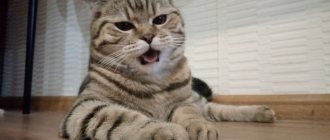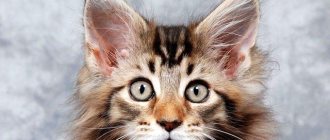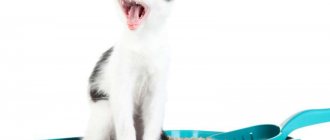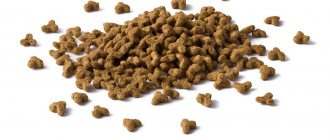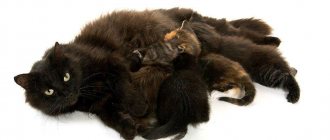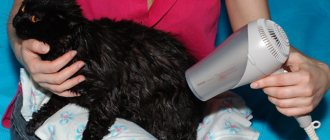10707Pavel
1
Cats, like other pets, are susceptible to infections of various origins and etiologies throughout their lives. In addition to viral-bacterial and invasive diseases, respiratory diseases are very often diagnosed in furry pets. Noticing that a cat has a stuffy nose, this may signal the development of an inflammatory process in the mucous membrane. As a rule, nasal congestion in felines is diagnosed with rhinitis, rhinotracheitis, and also if the pet is infected with the feline herpes virus.
Causes of nasal congestion?
Pets, particularly cats, are susceptible to many infectious diseases; they can catch colds due to a draft or resting on a cold floor. Diseases can be infectious or respiratory. If a cat sniffles through its nose, the reasons may be related specifically to the disease , the onset of an inflammatory process in the mucous membrane.
Rhinitis, rhinotracheitis, and the presence of feline herpes can be diagnosed by a veterinarian. He will tell you how to clean a cat’s nose to make breathing easier, and he will tell you how to treat the disease.
ATTENTION! With nasal congestion, it is difficult for a cat to assess its surroundings, because this organ is of great importance for orientation in space, finding food, and recognizing danger.
When an animal's nose is clogged and grunts, its existence is filled with a feeling of discomfort. And the owner is looking for an answer on how to wash a kitten or an adult pet’s olfactory organ. But first you need to establish the cause of the malaise:
- Inflammation in the nose can begin due to a viral-bacterial disease.
- Sometimes the cause is a parasitic disease.
- A cat may breathe poorly due to rhinitis, sinusitis, or rhinotracheitis.
- If the kitten cannot breathe through its nose, it may have become hypothermic on a cold floor or in a draft.
- The mucous membrane rots due to damage by various pathogenic and opportunistic microorganisms, which, under favorable conditions, especially develop their activity.
If a runny nose accompanies nasal congestion, chronic sluggish rhinitis is most likely due to a decrease in immune potential.
IMPORTANT! Particularly dangerous causes of nasal congestion are cat diseases such as calcivirosis, peritonitis, leukemia, viral pneumonia, feline herpes, and purulent conjunctivitis. Therefore, there is no need to hesitate to visit the veterinarian and self-medicate.
In most cases, a furry pet can be cured at home, but only with a professional diagnosis of the disease and treatment from a veterinarian . The nose becomes very clogged with helminthic infestation, when parasites in the lungs provoke inflammation in the respiratory tract of the body. In this case, it is not enough to put drops in the nose for a runny nose and wait for relief; first you need to get rid of the helminths.
If a cat does not breathe through its nose, it may have a severe allergy to hot steam, household chemicals, pollen, and chemicals .
Allergic reactions are typical for purebred cats, but they can be an individual feature of even a domestic animal. At the same time, the cat may have noticeable discharge, like a runny nose, the pet sneezes and snorts.
Allergic reaction
If your cat has a stuffy nose and watery eyes, he may have an allergy. This problem can be encountered regardless of the age of the animal. It is imperative to identify the reason why such symptoms occur and eliminate the allergen, which can be:
- dust particles;
- household chemicals;
- mold formation;
- perfumes or aerosols;
- tobacco smoke.
Sometimes it is very difficult to rid an animal of complete contact with an allergen. For example, when the flowers begin to bloom, the kitten may experience discomfort. Breathing becomes difficult, and due to constant itching in the nose, the animal begins to sneeze.
If a cat has a stuffy nose and the pet is sneezing, then experts recommend giving him antihistamine-type drugs. The most popular drug is “Suprastin”, while an adult animal will need only a quarter of a tablet per day.
Features of breathing problems in kittens
If a kitten’s nose is not breathing, what to do and how to treat it? Veterinarians will answer this question competently. Due to its age, a kitten does not yet have a developed immune system; it is easily susceptible to infection by viral, parasitic, and bacterial diseases. Diseases are caused by viruses, fungi, and pathogenic organisms. Even in the womb, the baby can be affected by a virus or bacteria .
INTERESTING! The owner of a small cat should be attentive to the living conditions of the animal. The baby may get sick due to low temperature in the house or hypothermia.
Also, breathing complications are caused by dirt in the nose and foreign objects . When the cat breathes through its mouth, without a nose, you can examine its olfactory organ for contamination.
Cat has a runny nose
Often cat owners are faced with a pet disease such as rhinitis . The cat suffers from a runny nose and a stuffy nose, because it loses its unique ability to accurately and quickly navigate the environment and recognize danger. What manifestations of rhinitis can be noticed?
- The animal not only has difficulty breathing through its nose, it cannot run or play calmly. It also becomes more lethargic, detached, loses appetite, and looks depressed.
- You can see the cat scratching its nose with its paw, fiddling with it, trying to clear it of congestion.
- Sometimes the temperature rises, even up to 39 degrees. If you touch your pet's nose, you can notice how hot it has become.
- Another sign of rhinitis can be conjunctivitis. It is necessary to wash the animal’s eyes so as not to aggravate the inflammation.
Caring for a sick animal
Many people are faced with the question of what to do if a cat has a stuffy nose. First of all, take care of peace so that the animal is warm and in a comfortable place. Be sure to give as much water as possible. Sometimes to do this you have to force the cat to drink using a syringe. Even if this does not help, then use a saline drip, since dehydration can occur very quickly. It is important to give soft food during illness.
Treatment of rhinitis
A runny nose and inflammation of the mucous membranes should be treated promptly ; there is no need to wait for complications for the pet to become deaf or for the inflammation to spread to other respiratory organs.
- If rhinitis occurs due to an infection, bacterial or viral, the veterinarian prescribes antibiotics and antibacterial drugs, taking into account the animal’s age and breed. It is important to strictly adhere to the instructions and carry out the course of treatment to the end, even if there is no discharge and the nose can breathe freely.
- The course of treatment for rhinitis may include antipyretic, anti-inflammatory, and sedative drugs.
- Sometimes the veterinarian recommends rinsing the animal’s nose to ease its breathing and general condition.
- Inhalations with essential oils are effective for rhinitis; you just need to strictly follow the dosage of oil drops. The nose is also warmed up with warm sand or salt wrapped in a clean cloth.
- If your pet has dry skin around its nose, you can constantly moisturize it with baby cream or Vaseline.
If you need to clear your nose, you should act very carefully and carefully , following the advice of experts. Wounds can not only cause pain, but also become a source of infection . You can clean the crusts with a damp cotton swab.
Treating nasal congestion in cats at home
Any owner's heart will break at the sight of a suffering pet. Therefore, it is necessary to know that a person can help his pet at home. To cure a runny nose and completely get rid of its symptoms, you must:
- If the congestion is caused by some kind of allergen, then it is necessary to remove the substance that affects your pet’s sense of smell.
Plants, or rather their pollen, are a common cause of allergic rhinitis in cats. - If you have sea sand or salt in your house, you can heat it in a frying pan, then wrap it in linen cloth and warm your cat’s nose with such a bag.
- You can rinse your animal's nose with a solution of boric acid or zinc sulfate, which are inexpensively sold in regular pharmacies.
- Freshly squeezed beet juice, saline solution or aloe juice are suitable for instillation into the nose.
- You can do mini-inhalation at home. To do this, you need to boil water in a saucepan and add a piece of Zvezdochka balm. Take the cat in your arms, cover with a terry towel, and breathe these vapors together with the cat for 15 minutes, 2 times a day.
- If your cat's runny nose is caused by hypothermia, keep her warm and calm.
If your cat's runny nose is caused by hypothermia, you need to provide her with warmth and rest.
If you do not know the exact cause of your pet's rhinitis, then the best option would be to consult a specialist. The veterinarian will determine the cause of the animal’s runny nose and draw up a comprehensive treatment plan using various medications.
What happens if your pet's nasal congestion is not treated?
A runny nose can develop into purulent rhinitis
When the mucous membranes in the nasal passage become inflamed, the cat does not receive the proper amount of oxygen.
Because of this, the functioning of all organs of the animal may deteriorate. After this, the pet will become passive, the appetite will worsen and the entire body will be exhausted. If acute rhinitis in a pet is not treated, it can develop into chronic rhinitis, which requires long-term treatment and increased care.
How to make breathing easier?
In this case, you will need special nasal drops that constrict the blood vessels. They should be dripped into each nostril of the nose, treatment will take about a week.
ATTENTION! Before you put drops in your pet's nose, you should first clean it of crusts. You cannot use cosmetics for this purpose that the cat can inhale.
For instillation, only drops for cats are used, no drugs for humans . Medicines for animals have such important additional properties as immunostimulating effects.
When treating kittens, medications are prescribed taking into account their young age. Sometimes even children's drops, such as Pinosol and Protargol, are suitable. You should only drip the number of times indicated in the instructions; an excess of the medicine will not bring any benefit , and there may even be complications.
You shouldn't rely on your intuition when treating your cat's nasal congestion or other health problems. There are videos on special websites that will help you treat your cat competently and safely. In any situation, pet owners should follow the recommendations of veterinarians and breeders who have professionally studied all the features of caring for cats .
Prevention
If the cat’s sneezing is harmless and caused by the presence of dust in the apartment, then the owners will need to keep their apartment clean and regularly carry out wet cleaning of the room. If sneezing is allergic, owners must protect their pet from the allergen (air freshener, perfume, perfume, washing powder, tobacco smoke, etc.).
An effective way to prevent the infectious component of cat sneezing is to vaccinate animals according to the existing schedule. Starting from six months, you need to follow the vaccination schedule and vaccinate them against: viruses; cat flu; leukemia and leukopenia; rabies.
Oral diseases are prevented by constant monitoring of the condition of the oral cavity and teeth, and timely removal of tartar.
Worm infestations in cats are prevented by regular deworming of the animal with anthelmintics.
The main thing is to undergo regular preventive examinations of your cat at a veterinary clinic in order to detect danger in time and begin timely treatment.
What can be the consequences of rhinitis?
An irresponsible cat owner can rely on a miracle and wait for the pet’s runny nose to go away on its own. But congestion and discharge, inflammation associated with colds or allergies, need to be treated and only as prescribed by a doctor.
If an animal does not breathe well, it does not receive the required amount of oxygen. Because of this, appetite and general condition worsen, and the body becomes exhausted. Acute rhinitis, with inactivity, becomes chronic, and it is much more difficult to treat .
Balanced diet
A balanced diet is another important preventive measure. To maintain strong immunity, the animal’s body must regularly receive a sufficient amount of necessary elements. There are 2 options for feeding a cat - give the animal high-quality food or include natural products in the diet.
Note! Experts prohibit putting food from the table into your pet's food bowl. It can harm his health, even if the cat eats it with pleasure.
Preventive measures
What to do to avoid a runny nose in a cat, which can cause its condition to worsen?
- It is necessary to avoid situations during which the cat may become hypothermic or catch a cold.
- Vaccination effectively helps prevent infectious and fungal diseases.
- It is important to increase the animal’s immunity through proper feeding.
- If your pet suffers from allergic reactions, sources of allergy should be excluded from the home environment. The source can even be food of a certain brand and composition.
Diseases caused by a virus
This infection can manifest itself in different ways, everything will depend on the body’s immunity. If a cat has a stuffy nose, loses appetite, has discharge from the eyes, and is generally lethargic, then one may suspect that the pet is suffering from a viral disease.
Sometimes other complications may be added to the symptoms already listed, so it is important to consult a doctor for treatment. Most often, Maksidin, Gamavit and Fosprenil are prescribed, which are used simultaneously. It is important to follow the recommended dosage.
